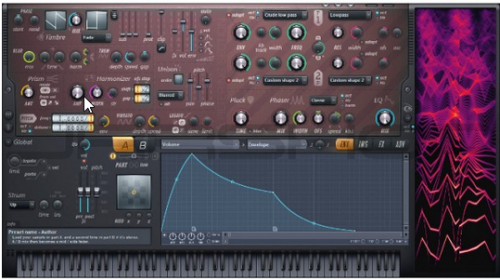-
Posts
3,803 -
Joined
-
Last visited
-
Days Won
17
Everything posted by TheSteven
-
Price is now $29.00 Updated thread title to reflect.
- 16 replies
-
- rx elements
- izotope
-
(and 1 more)
Tagged with:
-
Arghhhhhh Eventide installers still do not remember the installation location. Lame. So for every plugin I still have to change the plugin installation folders. I've contacted Eventide about this previously and was told it's 'on our radar'. If this issue affects you consider contacting Eventide's support or posting a comment on their forum. https://www.eventideaudio.com/community/forum/plug-ins/ I tried creating a thread but it's still pending administrative review. I've created a thread and it's now live. https://www.eventideaudio.com/community/forum/plug-ins/latest-plugin-updates-windows-still-wrong If you use Eventide plugins and this is an issue for you please add your 2 cents.
-
We are excited to announce another significant update of our flagship software synthesizer Omnisphere®. Version 2.6 adds an enhanced Arpeggiator and dramatically expanded Hardware Synth Integration, with support for over 60 Hardware Synths! This update adds brand new profiles for such iconic synths as the Roland Juno-106, Alesis Andromeda and the Roland D-50, to the very latest synths like the Korg Minilogue XD and Moog One - as well as dozens of other user requested models. The FREE update will also include hundreds of inspiring new patches for all registered Omnisphere 2 users and will be available in March. Major Arpeggiator Update Omnisphere’s renowned Arpeggiator has been greatly enhanced with all new creative tools, a brand new preset library and much more. The musical possibilities are vastly expanded, making it one of the most flexible arpeggiators ever, while still being fun to use. Best of all, Omnisphere 2.6 can now capture the MIDI data of what the arpeggiator is doing as a standard MIDI file, which can be dragged to any DAW for further editing! Expanded Hardware Synth Integration Omnisphere’s unique Hardware Synth Integration feature bridges the physical experience gap between software and hardware, giving users intuitive control of Omnisphere by using the familiar layout of their hardware synth. With the new 2.6 release, many requested hardware synth profiles have been added, including support for over 60 popular hardware synthesizers from Moog®, Sequential®, Roland®, Korg®, Novation®, Nord®, Behringer®, Access®, Studiologic® and Yamaha®. The supported hardware synths cover a wide array of form factors and price ranges for different types of users. New Sounds Omnisphere 2.6 features a newly expanded “Hardware Library” with hundreds of new patches created by Eric Persing and our renowned Sound Development team. Notably, this update takes Eric’s classic sound design work from the original 1987 Roland D-50 into completely new sonic territory with Omnisphere’s vast synthesis capabilities. New Hardware Synth Profiles added in v2.6 include: • Roland Juno-106 • Roland D-50/PG-1000 • Alesis Andromeda A6 • Behringer Deepmind • Access Virus Indigo 1 • Access Virus Indigo 2 • Access Virus C • Access Virus TI • DSI/Sequential Pro 2 • DSI/Sequential Prophet 08 • DSI/Sequential Mopho • Roland JP-8000 • Roland JP-8080 • Roland Gaia • Roland JD-Xi • Roland SH-201 • Nord Wave • Nord Lead 3 • Nord Lead 4 • Nord Lead A1 • Nord Stage 3 • Moog One • Moog Minitaur • Korg MicroKorg • Korg MicroKorg XL • Korg Minilogue XD • Korg MS-20i • Korg MS-2000 • Novation MiniNova • Yamaha Reface CS *complete list of new features and supported synths will be announced upon the official release in March 2019. Pricing and Availability Omnisphere 2.6 is a FREE update to all registered Omnisphere 2 users! Official Release March 2019 All specifications subject to change without notice. All trademarks are the property of their respective holders
- 8 replies
-
- 1
-

-
- omnisphere
- spectrasonics
-
(and 1 more)
Tagged with:
-

When Wave updates Mercury with a new plugin...
TheSteven replied to TheSteven's topic in Instruments & Effects
I forgot the process thanks for the reminder. The process did reinstall Mercury, not just the new plugin. Probably not anyway to avoid that. -
Looks like Eventide updated their VSTs on 9/28 Change log: 3.4.1 Updated installer to automatically place plugins in the correct filesystem location, without prompting (where applicable). Individual download links: 2016 Stereo Room https://www.eventideaudio.com/support/downloads/2016-stereo-room-native-windows-2 https://www.eventideaudio.com/support/downloads/2016-stereo-room-installer-mac Blackhole https://www.eventideaudio.com/support/downloads/blackhole-native-windows https://www.eventideaudio.com/support/downloads/blackhole-installer-mac H3000 Band Delays https://www.eventideaudio.com/support/downloads/h3000-band-delays-windows https://www.eventideaudio.com/support/downloads/h3000-band-delays-mac H3000 Factory https://www.eventideaudio.com/support/downloads/h3000-factory-windows https://www.eventideaudio.com/support/downloads/h3000-factory-mac H910 https://www.eventideaudio.com/support/downloads/h910-windows https://www.eventideaudio.com/support/downloads/h910-mac Octavox https://www.eventideaudio.com/support/downloads/octavox-native-windows https://www.eventideaudio.com/support/downloads/octavox-installer-mac Physion Installer https://www.eventideaudio.com/support/downloads/physion-installer-windows https://www.eventideaudio.com/support/downloads/physion-installer-mac Quadravox https://www.eventideaudio.com/support/downloads/quadravox-windows https://www.eventideaudio.com/support/downloads/quadravox-mac SP2016 Reverb (Win & Mac) https://www.eventideaudio.com/support/product/12013/installers TVerb https://www.eventideaudio.com/support/downloads/2016-stereo-room-installer-windows https://www.eventideaudio.com/support/downloads/2016-stereo-room-installer-mac Ultrachannel https://www.eventideaudio.com/support/downloads/ultrachannel-installer-windows https://www.eventideaudio.com/support/downloads/ultrachannel-installer-mac UltraTap https://www.eventideaudio.com/support/downloads/ultratap-installer-windows https://www.eventideaudio.com/support/downloads/ultratap-installer-mac or All downloads: https://www.eventideaudio.com/support/downloads
-
When Wave updates Mercury with a new plugin Can I just install the new plugin? or do I have to reinstall Mercury? I know that if I reinstall Mercury it'll show up but other route would be quicker. Question came to mind because Waves just released CLA MixHub https://discuss.cakewalk.com/index.php?/topic/1025-cla-mixhub-intro-waves/
-
and it's included free in Mercury! Available at EveryPlug http://everyplugin.com/cla-mixhub.html Price in cart $61.58
-
Spitfire London Contemporary Orchestra Textures has been released. Intro sale $199 (MSRP $299) Product Info 3468 Samples 28.5 GB Uncompressed .WAV 14.3 GB download size Too large to download? Choose hard drive delivery at checkout. 28.6 GB disk space required during install Mac system requirements Mac OS X 10.10 or later, Intel Core 2 Duo PC system requirements Windows 7, Windows 8, or Windows 10 (latest Service Pack, 32/64-bit) Intel Core 2 Duo or AMD Athlon 64 X2 Kontakt version requirements Kontakt or Kontakt Player 5.6.8 or higher Free Kontakt Player Included Trailer:
-
My question is pricing of upgrading TH3 to TH-U
-
Just bought and received license for RX7 Elements. Updated info in original post.
- 16 replies
-
- 1
-

-
- rx elements
- izotope
-
(and 1 more)
Tagged with:
-
This is a killer deal! https://www.jrrshop.com/izotope-music-productionsuite-upgrade-advanced iZotope Music Production Suite 2 Upgrade from Any Advanced Product $209.16 in cart with coupon: GROUP MSRP $499, sale price without code: $249 A collection of over thirty industry-standard plugins that interact across your session and provide time-saving assistive features, innovative new workflows, and cutting-edge visual analysis tools.
-
Lovely, so paid upgrades for anyone who bought in during the holiday sales. Hopefully the pricing is reasonable.
-
thank you Sir Larry!
-
https://www.bhphotovideo.com/c/product/1356812-REG/izotope_10_rxe_rx_elements_audio.html $9.99 for next 14 hours Note current version is RX Elements 7, this is v6 you will receive RX7 Elements license Product Highlights For Music/Post-Production Video Editing For Use in DAWs and NLEs Plug-In & Standalone Operations 4 Plug-Ins from RX 7 & Spectral Editing Spectral Repair De-Clip & De-Hum De-Click, Voice De-Noise Offline Editing of Gain, Polarity & More AAX Native, AudioSuite, RTAS, AU, & VST Mac OS X, Windows
- 16 replies
-
- 5
-

-

-
- rx elements
- izotope
-
(and 1 more)
Tagged with:
-
Couple of Harmor videos General overview of Harmor and its synthesis tools Harmor Vocal Resynthesis Also a gent who goes by the handle of Seamless has a whole series of informative Harmor tutorials. FL Studio Basics 32: Harmor Part 1: Additive Synthesis From The Ground Up
-
Image Line Harmor on sale for $59 https://www.jrrshop.com/image-line-harmor Cart price $52.51 with code: FORUM Additive / subtractive Just like its little brother Harmless, Harmor is driven by a powerful additive synthesis engine. Its modules will look familiar to subtractive synthesizer enthusiasts: oscillators, filters & phasers, these are featured in Harmor but, because performed through additive synthesis, offer more freedom. You don't just select filter types, you draw them. You wanted more, so also featured is the multipoint envelope editor of Sytrus fame, applied to over 40 parameters, in 2 independent parts. Through the same envelope/mappings, randomize any parameter or link it to key or velocity, and even fine-tune each unison voice independently. Processing units can be rearranged in a semi-modular way. If you need one of the 2 filter units processed after the blur unit, that's no problem. Image synthesis Because it typically requires manipulating large amounts (up to 500 per voice) of partials over time, additive synthesis is hard to handle. No human can (or even wants to) edit 500 envelopes, but editing 2D images, that we can do easily. Get access to gain & pitch planes which you can tweak in the image editor of your choice, and import any bitmap, even if it wasn't designed to be turned into audio, it might still sound interesting. Audio resynthesis Being an additive synthesizer, Harmor can resynthesize audio files as well. The reproduction will be faithful, not a vague sound-alike as in many additive synthesizers. Resynthesis can of course be tweaked, providing time stretching, pitch shifting, or less conventional manipulations of partials. And of course, the result of the analysis can still be turned into an image for further editing. Efficient Additive synthesis is generally very CPU-consuming, but not Harmor's engine. Its efficency is in fact, comparable to that of subtractive synthesizers. Voices may be generating hundreds of harmonics in parallel and still not overload the CPU. Processing being multi-threaded, extra CPU cores come in handy. Pixels! Resynthesis or image-synthesis, Harmor features both. Import a piece of audio and time-stretch or pitch-shift it (with formant and transient preservation). Convert this to an image and edit each partial individually! Two parts Two independent parts (or “layers”) for even more complex sounds. Parts can be imported from other presets. SFX In the effects section you will meet all the usual suspects: distortion, chorus, delay and reverb, as well as the mighty Soundgoodizer based on the Maximus engine. Just like processing units, effect slots can be re-ordered. Each part has its own effect mix amount. Looks pretty If you don't understand it, visualize what it's doing, best way to learn! Watch how each partial evolves in the built-in spectrogram, a picture is worth a thousand words. Don't forget to add to cart: Image Line Harmor Wavestation Wavetables - Free Download
-
If you make it simple how are we suppose to screw it up? (but really - thanks for your help and making things more transparent and easier)
-
Thanks for the clarification!
-
Do you have to have uploaded something to see this? Maybe I'm just not looking in the right place or have not activated something.
-

Is 192kHz hi-res audio recording in studio worth it?
TheSteven replied to Øyvind Skald's topic in The Coffee House
Then we top our efforts at achieving pristine quality in the final product by adding saturation and aggressive compression / limiting. -
Noticed the same thing. Edit: Yes the install set of the new update is full sized. 542Mb
-
The update fixes an issue with 'Download Stems' I'm not familiar with the issue but here's link to thread discussing it https://discuss.cakewalk.com/index.php?/topic/389-bandlab-questionsexperiences/&page=3&tab=comments#comment-7424 Update: Here's more info: https://discuss.cakewalk.com/index.php?/topic/389-bandlab-questionsexperiences/&do=findComment&comment=7597
-
Use Bandlab Assistant to access. Fixes an issue created with last update in Mix Recall**. Looks like the What's New doc has not been (yet) updated for this release. **This assumption is based on an announcement I saw yesterday by Jesse Jost that the previous update had broken Mix Recall and that a fix would be posted today. The currently posted What's New is the same as the previous post.



